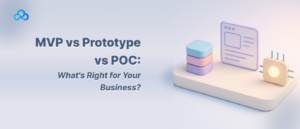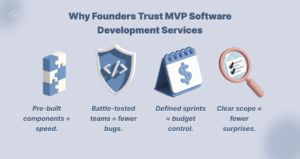Introduction

You’ve got a bold idea. Maybe it’s been stuck in your head for months, or maybe it just hit you in the middle of a late-night scroll. Either way, you’re itching to build. But here’s the reality check: more startups fail from building the wrong thing than from building nothing at all. It’s not always about bad execution. Sometimes, you simply launch too soon, build too much, or skip over the right checkpoints. And that’s where so many early-stage founders go sideways. In the chaotic world of startup MVP development, decisions around when to build, and what to build, are more than tactical. They’re existential. Choosing between a POC, a prototype, or a minimum viable product (MVP) isn’t just semantics. It’s a matter of time, money, survival, and ultimately, traction.
So let’s cut through the jargon and get real. What do these stages actually mean? When should you use each one? And how can MVP app development services help you avoid falling into the all-too-common trap of building something nobody needs?
POC, Prototype, and MVP: What They Really Mean
Let’s skip the fluff and get straight to it. These terms are not interchangeable. Each one serves a different purpose:
|
Type |
Purpose |
Audience |
Fidelity |
Cost |
Outcome |
|
POC |
Validate technical feasibility |
Internal team |
Low |
Low |
Go/no-go decision |
|
Prototype |
Show look and feel |
Stakeholders, users |
Medium |
Low-Moderate |
UX feedback |
|
MVP |
Deliver core functionality |
Early users |
High |
Higher |
Market validation |
Here’s a simple way to think about it:
-
A POC proves your tech won’t break.
-
A Prototype proves users won’t get lost.
-
An MVP proves people actually care.
Example: Imagine you’re building a smart delivery drone system.
-
The POC is a working motorized drone using your custom flight code.
-
The Prototype is a visual dashboard mockup for users to request deliveries.
-
The MVP is a real drone that takes real orders from real people.
Each step pulls you closer to a market-ready product, but jumping the gun can leave you with an expensive tool nobody needs.
When Should You Use Each One?
Go for a POC when:
-
You’re experimenting with unfamiliar APIs or machine learning models.
-
There’s a question mark around feasibility.
-
Your CTO says, “We’ve never built something like this before.”
Case: A deep-tech health startup uses a POC to test if their AI model can detect tumors in low-resolution scans. If it fails, there’s no point designing the interface.
Choose a Prototype when:
-
You want feedback from investors, users, or your design team.
-
You’re validating the interface before development.
-
You need to show, not just tell, what you’re building.
Case: A mental wellness app builds a clickable Figma prototype to test flow and accessibility with therapists.
Build an MVP when:
-
You’ve validated the concept and core user journey.
-
You want to launch and learn from actual users.
-
Your goal is market validation, not just feedback.
Case: A productivity SaaS tool launches with three key features: task tracking, reminders, and a calendar sync, no integrations, no fancy dashboards.
Startup MVP Development: Where Vision Meets Reality
Let’s be real: founders don’t have the luxury of endless pivots. You need results, fast. That’s why startup MVP development has become such a hot topic, and a non-negotiable phase for modern tech ventures.
With the help of specialized MVP app development services, founders are shipping lean, focused versions of their big ideas. These early builds are stripped down, yes, but they’re also smarter, sharper, and laser-focused on what matters.
Why it works:
- Custom MVP software development avoids feature creep.
- Agile teams build fast, test faster, and iterate on real feedback.
- You go to market in weeks, not years.
Stat: 42% of startups fail because they build something no one wants. MVPs help you dodge that bullet by testing actual demand.
Let’s Talk Numbers: MVP Cost and Timeline
|
Stage |
Timeline |
Estimated Cost (USD) |
|
POC |
1–3 weeks |
$2,000–$5,000 |
|
Prototype |
2–4 weeks |
$3,000–$8,000 |
|
MVP |
6–14 weeks |
$15,000–$60,000 |
You’ll notice startup MVP development cost isn’t cheap. That’s because it’s not just a test, it’s a real product. But with the right custom MVP software development partner, you can cut time, reduce waste, and still hit the market with something viable.
And don’t forget: analytics are your friend. Tools like Mixpanel, Hotjar, or even Google Analytics should be baked into your startup MVP development from day one. The goal is learning, not just launching.
Why Founders Trust MVP Software Development

Services
Outsourcing gets a bad rap, but not when it comes to building a focused MVP. Partnering with MVP software development services can be the smartest move you make. Here’s why:
-
Pre-built components = speed.
-
Battle-tested teams = fewer bugs.
-
Defined sprints = budget control.
-
Clear scope = fewer surprises.
Quick Case Study: A logistics startup outsourced their MVP. 10 weeks later, they had a geo-tracking platform in production. Within months, they raised $2M in pre-seed funding.
You don’t need an internal dev team, you need a reliable partner that knows how to build, ship, and iterate.
Founder Pitfalls to Watch Out For
-
Skipping the prototype phase to “save time”
-
Overbuilding your startup MVP development into a full app
-
Ignoring analytics and user behavior after launch
-
Building features based on assumptions, not interviews
Real Talk: MVP success isn’t about being perfect, it’s about being directionally right and willing to adapt.
Technical FAQs
Q1: Can I skip the prototype and go straight to MVP?
You could, but it’s risky. Even a lightweight prototype can uncover deal-breaking design issues that would be far more expensive to fix post-launch. Think of it as a safety net before you dive into full development. It’s a small investment for big clarity.
Q2: What tools are great for POCs?
Jupyter Notebooks for ML models, Postman for testing APIs, Swagger for API documentation, and even quick Python or JavaScript scripts for backend logic. The goal isn’t polish, it’s proving something works in principle.
Q3: What’s the real MVP cost?
On average: $15k to $60k. That range covers core functionality, bug testing, and post-launch iteration. Prices depend heavily on scope, team location, and whether you choose custom MVP software development or a DIY approach.
Q4: In-house vs MVP app development services?
In-house development gives you control but demands time and hiring resources. If speed, cost-efficiency, and proven results matter, and they usually do, outsourcing to MVP app development services is a solid choice.
Q5: Best stacks for MVP development?
You’ve got options: MERN (MongoDB, Express, React, Node) for full-stack web apps, Django + React for fast backends and flexible UIs, Flutter or React Native for mobile-first products. Even Bubble or Webflow work well for early no-code MVPs.
Q6: How do MVP software development services handle iteration?
With agile sprints, usually 1 to 2 weeks long, plus daily standups, sprint reviews, and user testing. The best teams keep the feedback loop tight, treat your startup MVP development like a learning tool, and iterate based on real data.
Final Thoughts: Don’t Just Build, Validate
If you’ve made it this far, here’s the truth nobody tells you loud enough: most failed products weren’t bad ideas. They were just never tested with real people. Never validated. Built in a vacuum, with best guesses instead of feedback.
That’s why this trio, POC, prototype, and MVP, exists. Each one gives you a clearer picture before you go all-in.
-
A POC helps you figure out if your tech stack holds up under pressure.
-
A prototype makes sure users don’t get confused, or worse, disinterested.
-
An MVP is your first shot at the real market. It’s your chance to stop guessing and start learning.
And here’s the kicker: when you partner with experienced MVP software development services, you’re not just paying for code. You’re buying speed, direction, and risk reduction. They help you move fast without stumbling blindly.
Because in the end, startup MVP development isn’t about building as much as you can, it’s about building only what matters, then learning quickly and adjusting accordingly.
So no, don’t aim for perfect. Aim for proof. Build just enough to learn what’s next. Then go build that.
Do you like to read more educational content? Read our blogs at Cloudastra Technologies or contact us for business enquiry at Cloudastra Contact Us